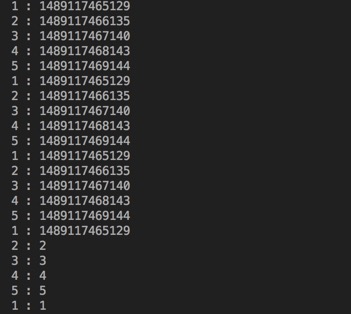Trees on the level UVA - 122 (二叉树建树)
Trees on the level
Background
Trees are fundamental in many branches of computer science. Current state-of-the art parallel computers such as Thinking Machines’ CM-5 are based on fat trees. Quad- and octal-trees are fundamental to many algorithms in computer graphics.
This problem involves building and traversing binary trees.
The Problem
Given a sequence of binary trees, you are to write a program that prints a level-order traversal of each tree. In this problem each node of a binary tree contains a positive integer and all binary trees have have fewer than 256 nodes.
In a level-order traversal of a tree, the data in all nodes at a given level are printed in left-to-right order and all nodes at level k are printed before all nodes at level k+1.
For example, a level order traversal of the tree
is: 5, 4, 8, 11, 13, 4, 7, 2, 1.
In this problem a binary tree is specified by a sequence of pairs (n,s) where n is the value at the node whose path from the root is given by the string s. A path is given be a sequence of L’s and R’s where L indicates a left branch and R indicates a right branch. In the tree diagrammed above, the node containing 13 is specified by (13,RL), and the node containing 2 is specified by (2,LLR). The root node is specified by (5,) where the empty string indicates the path from the root to itself. A binary tree is considered to be completely specified if every node on all root-to-node paths in the tree is given a value exactly once.
The Input
The input is a sequence of binary trees specified as described above. Each tree in a sequence consists of several pairs (n,s) as described above separated by whitespace. The last entry in each tree is (). No whitespace appears between left and right parentheses.
All nodes contain a positive integer. Every tree in the input will consist of at least one node and no more than 256 nodes. Input is terminated by end-of-file.
The Output
For each completely specified binary tree in the input file, the level order traversal of that tree should be printed. If a tree is not completely specified, i.e., some node in the tree is NOT given a value or a node is given a value more than once, then the string “not complete” should be printed.
Sample Input
(11,LL) (7,LLL) (8,R)
(5,) (4,L) (13,RL) (2,LLR) (1,RRR) (4,RR) ()
(3,L) (4,R) ()
Sample Output
5 4 8 11 13 4 7 2 1
not complete
解题思路:
#define _CRT_SECURE_NO_WARNINGS#include <iostream>#include <algorithm>#include <string.h>#include <queue>#include <stdio.h>#include <vector>using namespace std;const int MAXN = 300; //最多256个结点const int MAXD = 1010;char sn[MAXD]; //读取字符串bool bflag = true; //总领全局的判断函数vector<int> totalNodes, bfsNodes; //所有结点,遍历结点struct stNode{int stData;stNode* lchild, *rchild;bool have_value;stNode() {stData = -1;lchild = rchild = nullptr;have_value = false;}};stNode* newRoot = nullptr; //空结点void addNode(int v, char* s) {stNode* p = newRoot;int sindex = 0;while (true) {if (s[sindex] == 'L') { //向左边移动if (p->lchild == nullptr) p->lchild = new stNode();p = p->lchild;sindex++;}else if (s[sindex] == 'R') { //向右边移动if (p->rchild == nullptr) p->rchild = new stNode();p = p->rchild;sindex++;}else { //等于左括号if (p->have_value == true) { //bflag = false; //直接报错}p->stData = v;p->have_value = true;break; //退出循环}}}void deleteTree(stNode* root) {if (root == nullptr) return; //不用清,直接返回if (root->lchild != nullptr) deleteTree(root->lchild);if (root->rchild != nullptr) deleteTree(root->rchild);delete root;}bool sread_input() {deleteTree(newRoot);newRoot = new stNode(); //一开始就要赋值while (true) {int vnode;if (scanf("%s", sn) != 1) return false; //结束读取if (!strcmp(sn, "()")) break;sscanf(&sn[1], "%d", &vnode);totalNodes.push_back(vnode);addNode(vnode, strchr(sn, ',') + 1);}return true;}int main() {while (sread_input()) {queue<stNode*> bfs_queue;if (newRoot->stData != -1) {bfs_queue.push(newRoot);}while (!bfs_queue.empty()) {stNode* curNode = bfs_queue.front();bfs_queue.pop();if (curNode->stData != -1) {bfsNodes.push_back(curNode->stData); //插入数据}if (curNode->lchild != nullptr) {bfs_queue.push(curNode->lchild);}if (curNode->rchild != nullptr) {bfs_queue.push(curNode->rchild);}}if (bflag == false || bfsNodes.size() != totalNodes.size()) {printf("not complete\n"); //无效}else {for (int i = 0; i < bfsNodes.size(); ++i) {printf("%d", bfsNodes[i]);if (i < bfsNodes.size() - 1) printf(" ");}cout << endl;}totalNodes.clear();bfsNodes.clear();bflag = true;}system("PAUSE");return 0;}
































还没有评论,来说两句吧...